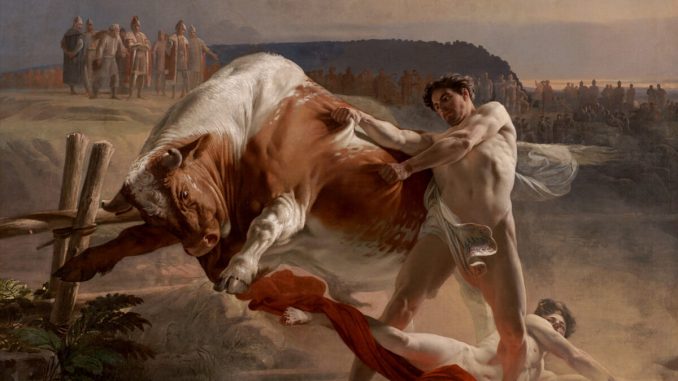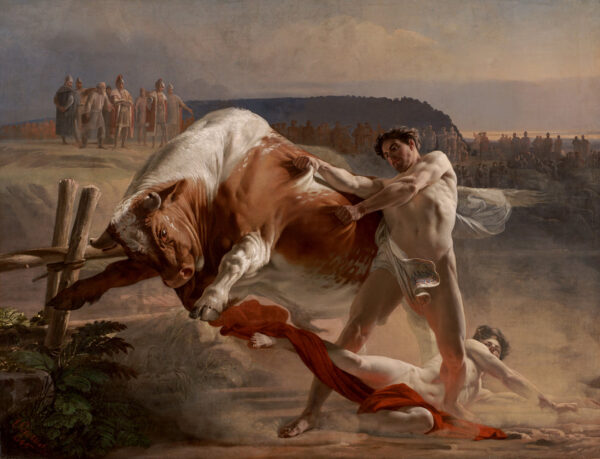
Sometimes we have the best intentions and push ourselves into becoming the best version of ourselves. We look in the mirror and say, “Today is the day I take a good look at myself and make the necessary changes in my character to become who I know I can be.”
For many of us, we try, but it’s not long before we find ourselves slipping back into those character flaws that prevent our improvement.
I came across a painting called “Ian Usmovets Stopping an Angry Bull” by the 19th-century Russian painter Evgraf Semenovich Sorokin. This painting, for me, is a visual representation of certain aspects of personal improvement.

‘Ian Usmovets Stopping an Angry Bull’
Sorokin depicted the Russian folk hero Ian Usmovets—the large muscular figure standing to the right of the composition.
As the story goes, Usmovets helped defeat the Pechenegs, thought to be a Turkic people, in 992. The Pechenegs summoned their strongman to challenge any hero of Grand Duke Vladimir.
An old man presented his youngest son, Usmovets, who was angry and ready to fight, to the duke. Usmovets’s strength was tested by the running bull that he grabbed with his bare hands, ripping the skin and flesh of the animal. The Pechenegs fled in defeat.
In the painting, Usmovets’s feet are planted into the ground; his upper body leans back, and with a calm rather than an angry face, he tightly clenches the flesh of the bull to restrain it.
The bull lunges forward and is caught mid-flight by Usmovets. The backward movement of Usmovets contrasts with the forward movement of the bull and creates tension in the middle of the composition.
On the ground between Usmovets’s legs is the strongman whom the bull appears to have trampled. The red matador cape falls and covers the bull’s victim.
The spectators in the background may be the grand duke and the Pechenegs. Some are dressed in elite or military attire, which suggests that this is an event of national pride that the people intentionally came to watch.
The Power of Restraint
Quite often, we try to push ourselves to accomplish our goals. We want to be the best version of ourselves, so we attempt to push ourselves to our limits.
However, with this approach, we may find ourselves tired and stressed from our efforts while gaining little actual improvement. Like the figure on the ground, our efforts end up in vain; we are trampled by the very things that impede our progress.
And what things impede our improvement? Impulsive desires—those desires that control us instead of us controlling them. For me, the raging bull represents our impulsive desires.
For example, how many times have we decided we were going to live a healthier lifestyle? We may have the initial determination to get started in this endeavor, but the impulse to eat junk food, for example, eventually resurfaces and prevents us from achieving the goal.
What if, instead of pushing ourselves to our limits, we focus first on pulling ourselves back from our impulses, that is, restraining ourselves? Usmovets represents this restraint. His feet are planted into the ground, which suggests inner resolve; and he is restraining the bull with his whole body, which suggests his strength.
Usmovets’s whole body is committed to restraining the bull, but his face is calm, which suggests that his mind is clear and quiet despite the raging bull in front of him. He is left unbothered by the tension expressed between him and the bull, and his calm expression makes him seem even more powerful.
This isn’t to suggest that our efforts to accomplish our goals are always for naught but only to ask what place calm restraint has in our achieving the best version of ourselves.
Is it the case that to get closer to our best selves, we must restrain our impulses and possess a calm mind? Does calm restraint provide us with a power we would otherwise lack?
Is it the case that this type of calm restraint will not only benefit our own lives but will also carry over into the lives of others? Able to approach situations calmly and with restraint, will we be able to better consider others in all that we do? Like the spectators in the background, will those around us see and take pride in our improvements?
The traditional arts often contain spiritual representations and symbols the meanings of which can be lost to our modern minds. In our series “Reaching Within: What Traditional Art Offers the Heart,” we interpret visual arts in ways that may be morally insightful for us today. We do not assume to provide absolute answers to questions generations have wrestled with, but hope that our questions will inspire a reflective journey toward our becoming more authentic, compassionate, and courageous human beings.
Eric Bess is a practicing representational artist and is a doctoral candidate at the Institute for Doctoral Studies in the Visual Arts (IDSVA).






Be the first to comment